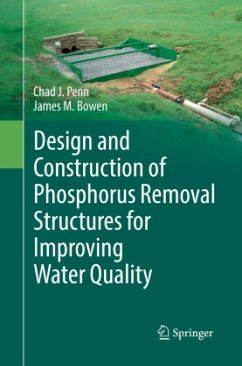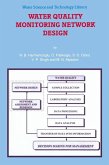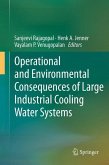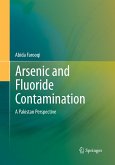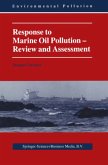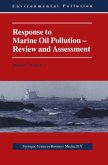Chad J. Penn, James M. Bowen
Design and Construction of Phosphorus Removal Structures for Improving Water Quality
Chad J. Penn, James M. Bowen
Design and Construction of Phosphorus Removal Structures for Improving Water Quality
- Broschiertes Buch
- Merkliste
- Auf die Merkliste
- Bewerten Bewerten
- Teilen
- Produkt teilen
- Produkterinnerung
- Produkterinnerung
The purpose of this book is to introduce the phosphorus (P) removal structure as a new BMP for reducing dissolved P loading to surface waters from non-point source pollution, provide guidance on designing site-specific P removal structures, and provide instruction on use of the design software, "Phrog" (Phosphorus Removal Online Guidance). The book initially provides a review of the nature and sources of non-point source P pollution, examines short and long term solutions to the problem, and provides detailed theory on design and operation of the P removal structure. As with many areas of…mehr
Andere Kunden interessierten sich auch für
![Hypoxia in the Northern Gulf of Mexico Hypoxia in the Northern Gulf of Mexico]() Virginia H. DaleHypoxia in the Northern Gulf of Mexico147,99 €
Virginia H. DaleHypoxia in the Northern Gulf of Mexico147,99 €![Water Quality Monitoring Network Design Water Quality Monitoring Network Design]() Nilgun B. HarmanciogammaluWater Quality Monitoring Network Design110,99 €
Nilgun B. HarmanciogammaluWater Quality Monitoring Network Design110,99 €![Operational and Environmental Consequences of Large Industrial Cooling Water Systems Operational and Environmental Consequences of Large Industrial Cooling Water Systems]() Operational and Environmental Consequences of Large Industrial Cooling Water Systems110,99 €
Operational and Environmental Consequences of Large Industrial Cooling Water Systems110,99 €![Arsenic and Fluoride Contamination Arsenic and Fluoride Contamination]() Abida FarooqiArsenic and Fluoride Contamination37,99 €
Abida FarooqiArsenic and Fluoride Contamination37,99 €![Water Treatment Technologies for the Removal of High-Toxity Pollutants Water Treatment Technologies for the Removal of High-Toxity Pollutants]() Miroslava Václavíková / Ksenija Vitale / Georgios P. et al. Gallios (Hrsg.)Water Treatment Technologies for the Removal of High-Toxity Pollutants147,99 €
Miroslava Václavíková / Ksenija Vitale / Georgios P. et al. Gallios (Hrsg.)Water Treatment Technologies for the Removal of High-Toxity Pollutants147,99 €![Response to Marine Oil Pollution Response to Marine Oil Pollution]() Douglas CormackResponse to Marine Oil Pollution116,99 €
Douglas CormackResponse to Marine Oil Pollution116,99 €![Response to Marine Oil Pollution Response to Marine Oil Pollution]() Douglas CormackResponse to Marine Oil Pollution110,99 €
Douglas CormackResponse to Marine Oil Pollution110,99 €-
-
-
The purpose of this book is to introduce the phosphorus (P) removal structure as a new BMP for reducing dissolved P loading to surface waters from non-point source pollution, provide guidance on designing site-specific P removal structures, and provide instruction on use of the design software, "Phrog" (Phosphorus Removal Online Guidance). The book initially provides a review of the nature and sources of non-point source P pollution, examines short and long term solutions to the problem, and provides detailed theory on design and operation of the P removal structure. As with many areas of study, one of the best methods of communicating concepts is through illustrations and examples. This book is no exception; several years of experience in studying P sorption and constructing P removal structures at multiple scales and settings is utilized for providing real examples and applications. With an understanding of the P removal structure established, the reader is instructed on how to obtain all of the necessary inputs for properly designing a site-specific P removal structure for meeting a desired lifetime and performance, or predict the performance and lifetime of a previously constructed P removal structure. For the readers who already possess the Phrog design software or are interested in obtaining it, one chapter is dedicated to detailed use of the software as demonstrated with various examples of structure design and also prediction.
Produktdetails
- Produktdetails
- Verlag: Springer / Springer International Publishing / Springer, Berlin
- Artikelnr. des Verlages: 978-3-319-86447-1
- Softcover reprint of the original 1st ed. 2018
- Seitenzahl: 248
- Erscheinungstermin: 12. August 2018
- Englisch
- Abmessung: 235mm x 155mm x 14mm
- Gewicht: 385g
- ISBN-13: 9783319864471
- ISBN-10: 3319864475
- Artikelnr.: 55126898
- Verlag: Springer / Springer International Publishing / Springer, Berlin
- Artikelnr. des Verlages: 978-3-319-86447-1
- Softcover reprint of the original 1st ed. 2018
- Seitenzahl: 248
- Erscheinungstermin: 12. August 2018
- Englisch
- Abmessung: 235mm x 155mm x 14mm
- Gewicht: 385g
- ISBN-13: 9783319864471
- ISBN-10: 3319864475
- Artikelnr.: 55126898
Dr. Chad Penn is a soil, agricultural, and environmental chemist at the USDA Agricultural Research Service (ARS). Before joining the ARS, he served as a professor of soil and environmental chemistry at Oklahoma State University for eleven years. He received his B.S. in soil science at Penn State University (1998) and M.S. in environmental soil science (2001). He earned his Ph.D. in environmental soil chemistry at Virginia Tech (2004). Dr. Penn has constructed over twenty phosphorus removal structures throughout the U.S., and helped to design many more in the U.S. and internationally. With his thirteen years of experience in conducting research on removing dissolved phosphorus from runoff, Dr. Penn created the software, "Phosphorus Removal Online Guidance" (Phrog), in an effort to disseminate the technology and enable the lay-person to more easily design and construct phosphorus removal structures. He has been a member of the National Academy of Inventors since 2015 and the American Society of Agronomy since 1997. Dr. Penn continues to help people around the world design phosphorus removal structures. Mr. James Bowen is pursuing a Ph.D. in the plant and soil sciences department with a concentration in soil fertility at the University of Kentucky. His research focuses on the spatial variability of soil phosphorus critical thresholds in agricultural systems. He has a BS in environmental science and an MS in soil science from Oklahoma State University. Mr. Bowen earned his M.S. degree under Dr. Penn while conducting research focused on design and quantification of phosphorus removal structures. He is a co-creator of the Phrog software.
1. Introduction to phosphorus and water quality
1.1. The role of phosphorus in ecosystems
1.1.1. Eutrophication
1.1.2. Cultural and Political Response to Eutrophication Issues
1.2. Sources of phosphorus transported to surface waters
1.2.1. Point Sources (Wastewater Treatment Plants)
1.2.2. Non-point phosphorus sources and forms
1.3. Best management practices and dissolved phosphorus losses
1.4. References
2. Reducing Phosphorus Transport: An Overview of Best Management Practices
2.1. Dealing with eutrophication: treat the symptoms or the cause?
2.2. Incidental vs. legacy phosphorus losses
2.3. Legacy phosphorus
2.3.1. Preventing legacy P from occurring
2.3.2. Containment of legacy phosphorus losses
2.3.3. Remediation of legacy phosphorus
2.4. References
3. Phosphorus Removal Structures as a Short-Term Solution for the Problem of Dissolved Phosphorus Transport to Surface Waters
3.1. Purpose, Concept, and General Theory of Phosphorus Removal Structures
3.1.1. How the phosphorus removal structure works for removing the target pollutant: dissolved phosphorus
3.1.2. Choosing the most efficient target locations for a phosphorus removal structure
3.2. Examples and applications of phosphorus removal structures
3.2.1. Modular box
3.2.2. Ditch-filter
3.2.3. Surface confined bed
3.2.4. Cartridges
3.2.5. Pond filter
3.2.6. Blind/surface inlets
3.2.7. Bio-retention cell
3.2.8. Subsurface tile drain filter
3.2.9. Waste-water treatment structures
3.2.10. Treatment at confined animal feeding operations
3.2.11. Treatment at silage bunkers
3.3. Summary of P removal structure styles
3.4. References
4. Phosphorus sorption materials (PSMs): the heart of the phosphorus removal structure
4.1. What are PSMs?
4.1.1.< Examples of PSMs
4.1.2. Choosing a PSM
4.2. What makes a material an effective PSM?
4.2.1. P sorption capacity and kinetics of P removal
4.2.2. Physical properties important to PSMs
4.2.3. Safety considerations of PSMs
4.3. The paradox of many PSMs
4.3.1. Potential solutions for PSMs with insufficient hydraulic conductivity
4.3.2. A note on the use of steel slag and chemical treatment
4.4. References
5. Characterization of PSMs
5.1. Measuring and estimating P removal: flow-through vs. batch tests
5.2. The P removal design curve
5.2.1. Method for direct measurement of the design curve: flow-through experiment
5.2.2. Indirect estimation of the P design curve through characterization of PSMs
5.3. Methods of physical characterization of PSMs necessary for designing a P removal structure
5.3.1. Measurement of bulk density
5.3.2. Measurement of porosity and particle density
5.3.3. Measurement of saturated hydraulic conductivity
5.4. Methods of safety characterization of PSMs
5.4.1. Total metal concentration by digestion
5.4.2. Method for water soluble metals
5.4.3. Synthetic precipitation leaching procedure (SPLP)
5.5. References
6. Designing a Phosphorus Removal Structure
6.1. Designing structures to achieve target P load removal and lifetime
6.1.1. Use of the design curve and governing equations for designing structures
6.1.2. Determining the required mass of PSM for a P removal structure
6.2. Site characterization inputs required for conducting a design
6.2.1. Average annual dissolved P load
6.2.2. Peak flow rates
6.2.3. Hydraulic head and maximum area for structure
6.3. Drainage of the P removal structure: balancing flow rate with retention time
6.3.1. Water flow through the P removal structure
6.3.2. Retention time
6.3.3. Drainage of the P removal structure
6.4. General procedure for conducting a structure design and information obtained
6.4.1. General design procedure
6.4.2. General results from conducting a proper design
6.5. Optional: total and particulate P removal with sediment reduction
6.5.1. Estimating sediment load reduction
6.5.2. Estimating total P and particulate P reductions from sediment removal within the structure
6.6. Further considerations in design and construction
6.6.1. Free drainage
6.6.2. Using a "cap layer" for fine-textured PSMs
6.6.3. Use of flow control structures
6.6.4. Overflow
6.7. References
7. Using the Phrog software
7.1. Designing a P removal structure vs. predicting performance of an existing structure
7.2. Two broad styles for P removal structures: bed vs. ditch structure
7.3. Specific inputs required for design of a P removal structure
7.3.1. Chemical and physical characteristics of PSM to be used
7.3.2. Site characteristics, constraints, and target P removal goals
7.3.3. Additional inputs for predicting performance of an existing structure
7.3.4. Optional inputs for estimating total and particulate P removal
7.4. General output from Phrog software when conducting a design
7.4.1. Output: physical construction specifications
7.4.2. Output: predicted structure performance and guidance in obtaining a suitable design
7.5. Case studies using Phrog to design or predict
7.5.1. Design a ditch structure: details of Phrog use and example of how to simultaneously meet the target flow rate and retention time
7.5.2. Predict performance of an existing ditch structure
7.5.3. Design a subsurface bed structure for treating tile drainage
7.5.4. Predict the performance of a blind inlet and demonstration of predicting particulate and total P removal
7.5.5. Bio-retention cells
7.5.6. Design a confined bed located on a CAFO
7.5.7. Wastewater treatment plant tertiary P treatment and example use of direct input of design curve coefficients
7.6. References
8. Disposal of Spent Phosphorus Sorption Materials
8.1. Use of spent PSMs as a P fertilizer
8.1.1. Testing PSMs to determine potential for P release to plants or runoff after land application to soil
8.2. Extraction of P from spent PSMs and potential recharge
8.2.1. Stripping P from spent PSMs: is it worth it?
8.3. Land application of spent PSMs to soils for benefits other than P fertilizer
8.3.1. Safety considerations in land application of spent PSMs
8.4. Alternative to land application of spent PSMs
8.5. 8.5 References
1.1. The role of phosphorus in ecosystems
1.1.1. Eutrophication
1.1.2. Cultural and Political Response to Eutrophication Issues
1.2. Sources of phosphorus transported to surface waters
1.2.1. Point Sources (Wastewater Treatment Plants)
1.2.2. Non-point phosphorus sources and forms
1.3. Best management practices and dissolved phosphorus losses
1.4. References
2. Reducing Phosphorus Transport: An Overview of Best Management Practices
2.1. Dealing with eutrophication: treat the symptoms or the cause?
2.2. Incidental vs. legacy phosphorus losses
2.3. Legacy phosphorus
2.3.1. Preventing legacy P from occurring
2.3.2. Containment of legacy phosphorus losses
2.3.3. Remediation of legacy phosphorus
2.4. References
3. Phosphorus Removal Structures as a Short-Term Solution for the Problem of Dissolved Phosphorus Transport to Surface Waters
3.1. Purpose, Concept, and General Theory of Phosphorus Removal Structures
3.1.1. How the phosphorus removal structure works for removing the target pollutant: dissolved phosphorus
3.1.2. Choosing the most efficient target locations for a phosphorus removal structure
3.2. Examples and applications of phosphorus removal structures
3.2.1. Modular box
3.2.2. Ditch-filter
3.2.3. Surface confined bed
3.2.4. Cartridges
3.2.5. Pond filter
3.2.6. Blind/surface inlets
3.2.7. Bio-retention cell
3.2.8. Subsurface tile drain filter
3.2.9. Waste-water treatment structures
3.2.10. Treatment at confined animal feeding operations
3.2.11. Treatment at silage bunkers
3.3. Summary of P removal structure styles
3.4. References
4. Phosphorus sorption materials (PSMs): the heart of the phosphorus removal structure
4.1. What are PSMs?
4.1.1.< Examples of PSMs
4.1.2. Choosing a PSM
4.2. What makes a material an effective PSM?
4.2.1. P sorption capacity and kinetics of P removal
4.2.2. Physical properties important to PSMs
4.2.3. Safety considerations of PSMs
4.3. The paradox of many PSMs
4.3.1. Potential solutions for PSMs with insufficient hydraulic conductivity
4.3.2. A note on the use of steel slag and chemical treatment
4.4. References
5. Characterization of PSMs
5.1. Measuring and estimating P removal: flow-through vs. batch tests
5.2. The P removal design curve
5.2.1. Method for direct measurement of the design curve: flow-through experiment
5.2.2. Indirect estimation of the P design curve through characterization of PSMs
5.3. Methods of physical characterization of PSMs necessary for designing a P removal structure
5.3.1. Measurement of bulk density
5.3.2. Measurement of porosity and particle density
5.3.3. Measurement of saturated hydraulic conductivity
5.4. Methods of safety characterization of PSMs
5.4.1. Total metal concentration by digestion
5.4.2. Method for water soluble metals
5.4.3. Synthetic precipitation leaching procedure (SPLP)
5.5. References
6. Designing a Phosphorus Removal Structure
6.1. Designing structures to achieve target P load removal and lifetime
6.1.1. Use of the design curve and governing equations for designing structures
6.1.2. Determining the required mass of PSM for a P removal structure
6.2. Site characterization inputs required for conducting a design
6.2.1. Average annual dissolved P load
6.2.2. Peak flow rates
6.2.3. Hydraulic head and maximum area for structure
6.3. Drainage of the P removal structure: balancing flow rate with retention time
6.3.1. Water flow through the P removal structure
6.3.2. Retention time
6.3.3. Drainage of the P removal structure
6.4. General procedure for conducting a structure design and information obtained
6.4.1. General design procedure
6.4.2. General results from conducting a proper design
6.5. Optional: total and particulate P removal with sediment reduction
6.5.1. Estimating sediment load reduction
6.5.2. Estimating total P and particulate P reductions from sediment removal within the structure
6.6. Further considerations in design and construction
6.6.1. Free drainage
6.6.2. Using a "cap layer" for fine-textured PSMs
6.6.3. Use of flow control structures
6.6.4. Overflow
6.7. References
7. Using the Phrog software
7.1. Designing a P removal structure vs. predicting performance of an existing structure
7.2. Two broad styles for P removal structures: bed vs. ditch structure
7.3. Specific inputs required for design of a P removal structure
7.3.1. Chemical and physical characteristics of PSM to be used
7.3.2. Site characteristics, constraints, and target P removal goals
7.3.3. Additional inputs for predicting performance of an existing structure
7.3.4. Optional inputs for estimating total and particulate P removal
7.4. General output from Phrog software when conducting a design
7.4.1. Output: physical construction specifications
7.4.2. Output: predicted structure performance and guidance in obtaining a suitable design
7.5. Case studies using Phrog to design or predict
7.5.1. Design a ditch structure: details of Phrog use and example of how to simultaneously meet the target flow rate and retention time
7.5.2. Predict performance of an existing ditch structure
7.5.3. Design a subsurface bed structure for treating tile drainage
7.5.4. Predict the performance of a blind inlet and demonstration of predicting particulate and total P removal
7.5.5. Bio-retention cells
7.5.6. Design a confined bed located on a CAFO
7.5.7. Wastewater treatment plant tertiary P treatment and example use of direct input of design curve coefficients
7.6. References
8. Disposal of Spent Phosphorus Sorption Materials
8.1. Use of spent PSMs as a P fertilizer
8.1.1. Testing PSMs to determine potential for P release to plants or runoff after land application to soil
8.2. Extraction of P from spent PSMs and potential recharge
8.2.1. Stripping P from spent PSMs: is it worth it?
8.3. Land application of spent PSMs to soils for benefits other than P fertilizer
8.3.1. Safety considerations in land application of spent PSMs
8.4. Alternative to land application of spent PSMs
8.5. 8.5 References
1. Introduction to phosphorus and water quality
1.1. The role of phosphorus in ecosystems
1.1.1. Eutrophication
1.1.2. Cultural and Political Response to Eutrophication Issues
1.2. Sources of phosphorus transported to surface waters
1.2.1. Point Sources (Wastewater Treatment Plants)
1.2.2. Non-point phosphorus sources and forms
1.3. Best management practices and dissolved phosphorus losses
1.4. References
2. Reducing Phosphorus Transport: An Overview of Best Management Practices
2.1. Dealing with eutrophication: treat the symptoms or the cause?
2.2. Incidental vs. legacy phosphorus losses
2.3. Legacy phosphorus
2.3.1. Preventing legacy P from occurring
2.3.2. Containment of legacy phosphorus losses
2.3.3. Remediation of legacy phosphorus
2.4. References
3. Phosphorus Removal Structures as a Short-Term Solution for the Problem of Dissolved Phosphorus Transport to Surface Waters
3.1. Purpose, Concept, and General Theory of Phosphorus Removal Structures
3.1.1. How the phosphorus removal structure works for removing the target pollutant: dissolved phosphorus
3.1.2. Choosing the most efficient target locations for a phosphorus removal structure
3.2. Examples and applications of phosphorus removal structures
3.2.1. Modular box
3.2.2. Ditch-filter
3.2.3. Surface confined bed
3.2.4. Cartridges
3.2.5. Pond filter
3.2.6. Blind/surface inlets
3.2.7. Bio-retention cell
3.2.8. Subsurface tile drain filter
3.2.9. Waste-water treatment structures
3.2.10. Treatment at confined animal feeding operations
3.2.11. Treatment at silage bunkers
3.3. Summary of P removal structure styles
3.4. References
4. Phosphorus sorption materials (PSMs): the heart of the phosphorus removal structure
4.1. What are PSMs?
4.1.1.< Examples of PSMs
4.1.2. Choosing a PSM
4.2. What makes a material an effective PSM?
4.2.1. P sorption capacity and kinetics of P removal
4.2.2. Physical properties important to PSMs
4.2.3. Safety considerations of PSMs
4.3. The paradox of many PSMs
4.3.1. Potential solutions for PSMs with insufficient hydraulic conductivity
4.3.2. A note on the use of steel slag and chemical treatment
4.4. References
5. Characterization of PSMs
5.1. Measuring and estimating P removal: flow-through vs. batch tests
5.2. The P removal design curve
5.2.1. Method for direct measurement of the design curve: flow-through experiment
5.2.2. Indirect estimation of the P design curve through characterization of PSMs
5.3. Methods of physical characterization of PSMs necessary for designing a P removal structure
5.3.1. Measurement of bulk density
5.3.2. Measurement of porosity and particle density
5.3.3. Measurement of saturated hydraulic conductivity
5.4. Methods of safety characterization of PSMs
5.4.1. Total metal concentration by digestion
5.4.2. Method for water soluble metals
5.4.3. Synthetic precipitation leaching procedure (SPLP)
5.5. References
6. Designing a Phosphorus Removal Structure
6.1. Designing structures to achieve target P load removal and lifetime
6.1.1. Use of the design curve and governing equations for designing structures
6.1.2. Determining the required mass of PSM for a P removal structure
6.2. Site characterization inputs required for conducting a design
6.2.1. Average annual dissolved P load
6.2.2. Peak flow rates
6.2.3. Hydraulic head and maximum area for structure
6.3. Drainage of the P removal structure: balancing flow rate with retention time
6.3.1. Water flow through the P removal structure
6.3.2. Retention time
6.3.3. Drainage of the P removal structure
6.4. General procedure for conducting a structure design and information obtained
6.4.1. General design procedure
6.4.2. General results from conducting a proper design
6.5. Optional: total and particulate P removal with sediment reduction
6.5.1. Estimating sediment load reduction
6.5.2. Estimating total P and particulate P reductions from sediment removal within the structure
6.6. Further considerations in design and construction
6.6.1. Free drainage
6.6.2. Using a "cap layer" for fine-textured PSMs
6.6.3. Use of flow control structures
6.6.4. Overflow
6.7. References
7. Using the Phrog software
7.1. Designing a P removal structure vs. predicting performance of an existing structure
7.2. Two broad styles for P removal structures: bed vs. ditch structure
7.3. Specific inputs required for design of a P removal structure
7.3.1. Chemical and physical characteristics of PSM to be used
7.3.2. Site characteristics, constraints, and target P removal goals
7.3.3. Additional inputs for predicting performance of an existing structure
7.3.4. Optional inputs for estimating total and particulate P removal
7.4. General output from Phrog software when conducting a design
7.4.1. Output: physical construction specifications
7.4.2. Output: predicted structure performance and guidance in obtaining a suitable design
7.5. Case studies using Phrog to design or predict
7.5.1. Design a ditch structure: details of Phrog use and example of how to simultaneously meet the target flow rate and retention time
7.5.2. Predict performance of an existing ditch structure
7.5.3. Design a subsurface bed structure for treating tile drainage
7.5.4. Predict the performance of a blind inlet and demonstration of predicting particulate and total P removal
7.5.5. Bio-retention cells
7.5.6. Design a confined bed located on a CAFO
7.5.7. Wastewater treatment plant tertiary P treatment and example use of direct input of design curve coefficients
7.6. References
8. Disposal of Spent Phosphorus Sorption Materials
8.1. Use of spent PSMs as a P fertilizer
8.1.1. Testing PSMs to determine potential for P release to plants or runoff after land application to soil
8.2. Extraction of P from spent PSMs and potential recharge
8.2.1. Stripping P from spent PSMs: is it worth it?
8.3. Land application of spent PSMs to soils for benefits other than P fertilizer
8.3.1. Safety considerations in land application of spent PSMs
8.4. Alternative to land application of spent PSMs
8.5. 8.5 References
1.1. The role of phosphorus in ecosystems
1.1.1. Eutrophication
1.1.2. Cultural and Political Response to Eutrophication Issues
1.2. Sources of phosphorus transported to surface waters
1.2.1. Point Sources (Wastewater Treatment Plants)
1.2.2. Non-point phosphorus sources and forms
1.3. Best management practices and dissolved phosphorus losses
1.4. References
2. Reducing Phosphorus Transport: An Overview of Best Management Practices
2.1. Dealing with eutrophication: treat the symptoms or the cause?
2.2. Incidental vs. legacy phosphorus losses
2.3. Legacy phosphorus
2.3.1. Preventing legacy P from occurring
2.3.2. Containment of legacy phosphorus losses
2.3.3. Remediation of legacy phosphorus
2.4. References
3. Phosphorus Removal Structures as a Short-Term Solution for the Problem of Dissolved Phosphorus Transport to Surface Waters
3.1. Purpose, Concept, and General Theory of Phosphorus Removal Structures
3.1.1. How the phosphorus removal structure works for removing the target pollutant: dissolved phosphorus
3.1.2. Choosing the most efficient target locations for a phosphorus removal structure
3.2. Examples and applications of phosphorus removal structures
3.2.1. Modular box
3.2.2. Ditch-filter
3.2.3. Surface confined bed
3.2.4. Cartridges
3.2.5. Pond filter
3.2.6. Blind/surface inlets
3.2.7. Bio-retention cell
3.2.8. Subsurface tile drain filter
3.2.9. Waste-water treatment structures
3.2.10. Treatment at confined animal feeding operations
3.2.11. Treatment at silage bunkers
3.3. Summary of P removal structure styles
3.4. References
4. Phosphorus sorption materials (PSMs): the heart of the phosphorus removal structure
4.1. What are PSMs?
4.1.1.< Examples of PSMs
4.1.2. Choosing a PSM
4.2. What makes a material an effective PSM?
4.2.1. P sorption capacity and kinetics of P removal
4.2.2. Physical properties important to PSMs
4.2.3. Safety considerations of PSMs
4.3. The paradox of many PSMs
4.3.1. Potential solutions for PSMs with insufficient hydraulic conductivity
4.3.2. A note on the use of steel slag and chemical treatment
4.4. References
5. Characterization of PSMs
5.1. Measuring and estimating P removal: flow-through vs. batch tests
5.2. The P removal design curve
5.2.1. Method for direct measurement of the design curve: flow-through experiment
5.2.2. Indirect estimation of the P design curve through characterization of PSMs
5.3. Methods of physical characterization of PSMs necessary for designing a P removal structure
5.3.1. Measurement of bulk density
5.3.2. Measurement of porosity and particle density
5.3.3. Measurement of saturated hydraulic conductivity
5.4. Methods of safety characterization of PSMs
5.4.1. Total metal concentration by digestion
5.4.2. Method for water soluble metals
5.4.3. Synthetic precipitation leaching procedure (SPLP)
5.5. References
6. Designing a Phosphorus Removal Structure
6.1. Designing structures to achieve target P load removal and lifetime
6.1.1. Use of the design curve and governing equations for designing structures
6.1.2. Determining the required mass of PSM for a P removal structure
6.2. Site characterization inputs required for conducting a design
6.2.1. Average annual dissolved P load
6.2.2. Peak flow rates
6.2.3. Hydraulic head and maximum area for structure
6.3. Drainage of the P removal structure: balancing flow rate with retention time
6.3.1. Water flow through the P removal structure
6.3.2. Retention time
6.3.3. Drainage of the P removal structure
6.4. General procedure for conducting a structure design and information obtained
6.4.1. General design procedure
6.4.2. General results from conducting a proper design
6.5. Optional: total and particulate P removal with sediment reduction
6.5.1. Estimating sediment load reduction
6.5.2. Estimating total P and particulate P reductions from sediment removal within the structure
6.6. Further considerations in design and construction
6.6.1. Free drainage
6.6.2. Using a "cap layer" for fine-textured PSMs
6.6.3. Use of flow control structures
6.6.4. Overflow
6.7. References
7. Using the Phrog software
7.1. Designing a P removal structure vs. predicting performance of an existing structure
7.2. Two broad styles for P removal structures: bed vs. ditch structure
7.3. Specific inputs required for design of a P removal structure
7.3.1. Chemical and physical characteristics of PSM to be used
7.3.2. Site characteristics, constraints, and target P removal goals
7.3.3. Additional inputs for predicting performance of an existing structure
7.3.4. Optional inputs for estimating total and particulate P removal
7.4. General output from Phrog software when conducting a design
7.4.1. Output: physical construction specifications
7.4.2. Output: predicted structure performance and guidance in obtaining a suitable design
7.5. Case studies using Phrog to design or predict
7.5.1. Design a ditch structure: details of Phrog use and example of how to simultaneously meet the target flow rate and retention time
7.5.2. Predict performance of an existing ditch structure
7.5.3. Design a subsurface bed structure for treating tile drainage
7.5.4. Predict the performance of a blind inlet and demonstration of predicting particulate and total P removal
7.5.5. Bio-retention cells
7.5.6. Design a confined bed located on a CAFO
7.5.7. Wastewater treatment plant tertiary P treatment and example use of direct input of design curve coefficients
7.6. References
8. Disposal of Spent Phosphorus Sorption Materials
8.1. Use of spent PSMs as a P fertilizer
8.1.1. Testing PSMs to determine potential for P release to plants or runoff after land application to soil
8.2. Extraction of P from spent PSMs and potential recharge
8.2.1. Stripping P from spent PSMs: is it worth it?
8.3. Land application of spent PSMs to soils for benefits other than P fertilizer
8.3.1. Safety considerations in land application of spent PSMs
8.4. Alternative to land application of spent PSMs
8.5. 8.5 References

